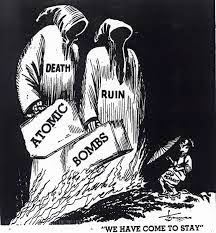World War II was a time period
characterized by ambiguity and depression, and the overarching fear of humanity’s
destructive potential was, ironically, manifested at its height during the end
of the gruesome war, characterized most prominently by the devastating power of
atomic bombs on Japanese land. Responding to the fearsome atomic bombs, on
August 8 of 1945 an American newspaper, The
Anderson Independent, published the political cartoon “We have come to stay”
and straightforwardly and effectively questioned the future of humanity under
such precarious foundations.
What made the implications of the
political cartoon seem even more convincing was its use of historical
reference. When the cartoon was released, the news of Japan being nuked was
widespread around the world, and most, if not all, of the American people were
probably aware of the fact. In the cartoon, the human wearing Japanese
traditional clothes, shoes, and umbrella is definitely an representation of
Japan. The atomic bombs had already visited Japan, the readers knew it and the
author knew it. Yet, what neither the author nor the readers knew, and what the
author was driving toward, was if the United States, if humanity, would follow
the same fate as Japan in the future.
The answer was and still is uncertain.

No comments:
Post a Comment